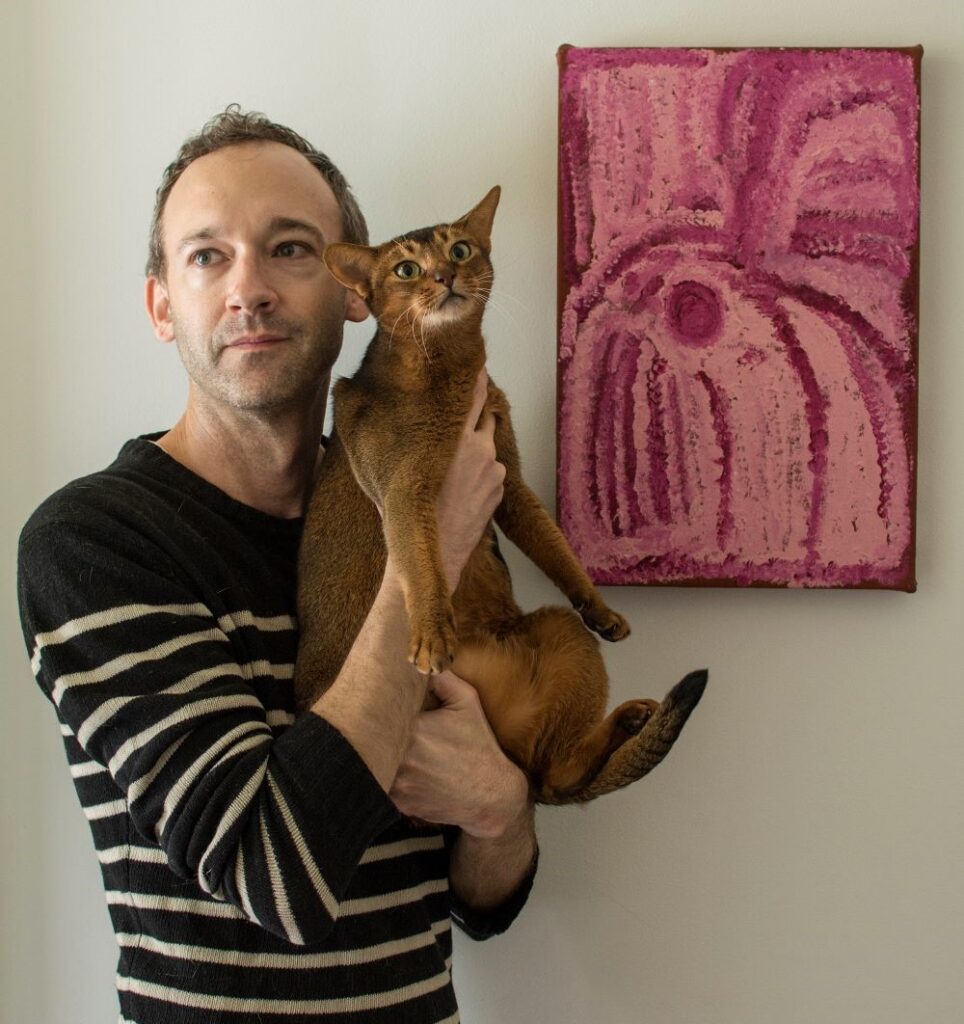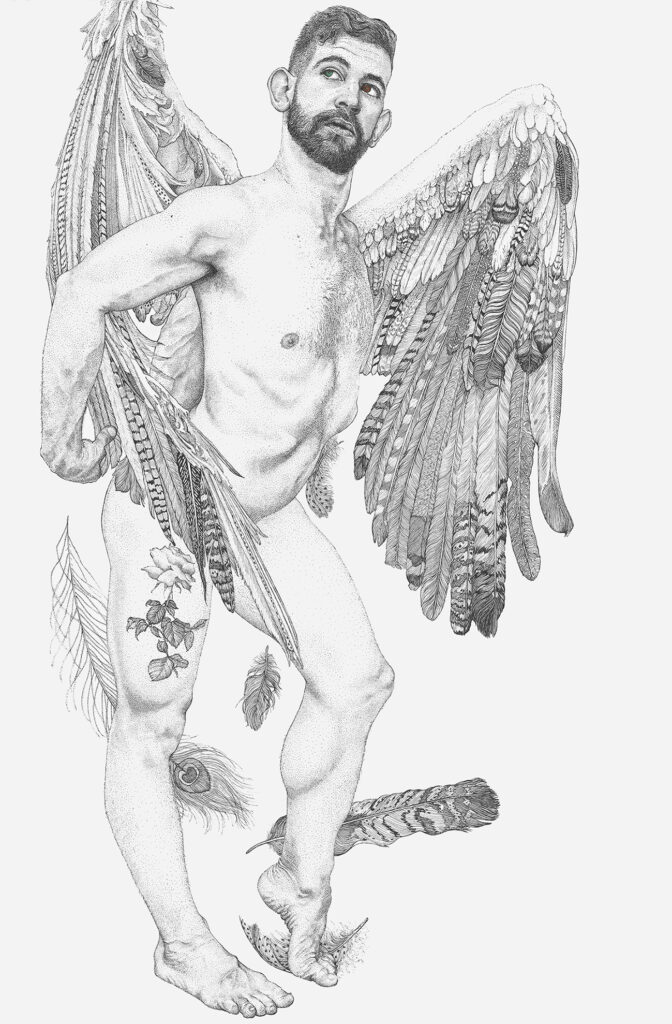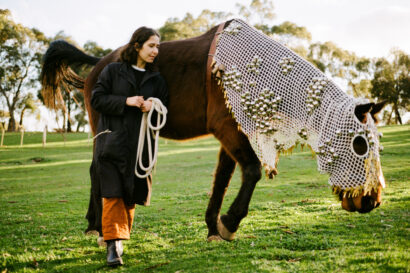In this instalment of ‘A day in the life’ we hear from visual artist Andrew Nicholls who finds much to love in his intensely productive COVID-enforced lockdown.
Tainted love
25 May 2020
- Reading time • 9 minutesVisual Art
More like this
- A walk with Tina Stefanou
- A blaze of glorious people
- Diving into the gothic world of Erin Coates
You may have seen his ceiling mural at the City of Perth library, or bumped into him during a residency at an iconic location like the Spode China Factory, the Freud Museum London or the Museo Nazionale del Bargello, Florence. Currently, however, Australian/British artist, writer and curator Andrew Nicholls is making the most of his iso-residency at home in Perth.
I’m just going to say it. I love the COVID lockdown. It is a love tainted with deep sadness of course, and the guilt of privilege and first world problems, but I love it nonetheless. We visual artists are often solitary creatures. I’m sociable in my personal life, but my studio time is largely spent blissfully alone with a pen and paper, and so long as I can make work, I don’t actually require time with other people. Additionally my work is extremely time consuming, and it’s my norm to be consistently behind on multiple deadlines. The opportunity to spend several unscheduled weeks at home drawing has therefore been immensely enjoyable. Mind you, I also have a full-time curatorial role with a local arts organisation, so I’m on paid leave for the first part of lockdown, well aware that many others are not so lucky.
Not everything about the pandemic is positive for my practice of course. To avoid risking unnecessary exposure I decide to work from home, while still paying rent for my studio. I also travel a lot for my work, and it’s been almost a decade since I’ve spent more than a few consecutive months in Australia. The thought that our borders may be closed for a year or more niggles at the edges of my consciousness as a creeping anxiety – one of those first world problems I mentioned.

Nonetheless, the positives for my practice and personal life far outweigh the negatives. Just prior to the lockdown – mercifully two days before the government put a hold on evictions – I manage to rid myself of a toxic housemate, and my beloved Abyssinian, Crazy, returns home after boarding with friends for several weeks while I was on a residency in Singapore. As such I relish my newfound solitude, and Crazy’s presence takes the edge off whatever loneliness I may otherwise have felt. He curls up in my lap for hours as I draw at the dining table like a velvet hot water bottle, and then suddenly decides that it’s hilarious (which it is) to jump onto my back and doze, draped across my shoulders while I work.
In addition to drawing I surprise myself by actually doing all those things Instagram tells me I should. I vigorously clean the house to dispel ex-housemate vibes, and finally start tackling the junk room that has been festering at the back of the house for a decade like a canker. I cook proper meals for myself for the first time in months. My pantry and linen press have never been more organised. I actually join in the (g-rated) home workouts my favourite porn star posts on Instagram each day, instead of just thirstily watching. I even start meditating – something that will sound hilarious to anyone familiar with my hard-grained cynicism toward such things – and am surprised to find that I love it.
Nonetheless, the first few weeks are deeply surreal. I have to keep reminding myself that it’s actually happening, at which point the grief and fear engulf me afresh. I read WHO updates obsessively and structure my time around checking in with friends and family across the globe. China and Italy are the two places I return to regularly to nourish my art practice, and my heart breaks at the horror unfolding in each. I brace myself for the escalation in London and New York. I have friends in all those places, some of whom have severely compromised immune systems.
I also have parents in their mid-eighties. My mother is a retired nurse and therefore considers herself pretty much indestructible, and it takes all my powers of persuasion to convince her to stay home. Every time I call to see if they need anything I’m told – maddeningly – that my father just returned from the supermarket. I manage to get my own grocery shopping down to once a fortnight, and a friend forces me to leave the house every two days for a (socially-distanced) walk, a blessing as otherwise I would barely see the sun. Over time I shift from having to remind myself that it’s actually happening, to reminding myself that it’s still going on, suddenly thinking that I could meet a friend at the pub, or go out for a meal. Days merge together and time becomes fuzzy.

After a few weeks of solitude things begin to emerge startlingly and unprovoked from the recesses of my memory. Back in art school I was obsessed by Stravinsky’s Le Sacre du Printemps, the iconic Ballet Russes commission so confronting in its brutal modernity that it allegedly provoked a riot at its premiere in 1913, and was only performed seven times in its original form. Obsessive over-listening meant that I have not been able to revisit it since my late teens, but in the midst of the lockdown it bursts into my consciousness and I’m delighted to realise that I can hear it again with fresh ears. I discover Nijinsky’s original choreography, thought lost to time, painstakingly pieced together by Chicago’s Joffrey Ballet with replicas of the original sets and costumes on Youtube. Spellbound I watch it four times in a row, feeling more excited by a creative work than I have been in years. A profoundly inspiring deep dive into Nijinsky’s legacy ensues that would never have happened if it weren’t for COVID.
At other times my energy plummets. The saga of the Federal Government disregard for arts industry workers plays out with tedious inevitability. I’m Chairman of an artist-run studio and it takes me seven weeks of negotiation to wrangle a meagre rent reduction – half of what we had hoped for – because, since we’re not-for-profit, our landlords are limited in their capacity to offer us relief on our commercial lease. After a month of leave I switch to Jobkeeper and watch my meagre savings begin to deplete, but I’m incredibly grateful to have it, and – more to the point – a job to return to. I’m well aware that I’m one of the lucky ones; most of my artist friends are ineligible for Jobkeeper. My spirits dive at the news that my local, The Flying Scotsman will not reopen after the quarantine, thanks to the never-ceasing parasitic greed of Beaufort Street property owners. I wonder which of my other favourite haunts will not survive the crisis. Things get weirder. I become briefly but passionately addicted to online Mahjong. My reading list reels alarmingly between a history of Michaelangelo’s David and The Simon Necronomicon.
However, overall my lockdown is intensely productive. I begin several new drawings, all in a larger scale than I would normally commit to, and experiment with new techniques because I have the rare luxury of time. Though I’ve had numerous upcoming exhibitions postponed I’m absolutely fine to have more time to work on them – delighted in fact – and I apply for a swathe of opportunities and awards that I would normally run out of time for.
As I write these words restrictions have begun easing. Next week I return to the office and, I expect, grapple with my inevitable depression at no longer being a full-time artist. I’m fairly sure I’m not alone in this guilt-ridden relief/regret, and as we begin to emerge into whatever normality might be now, I plan to take solace from the spectacular visual artworks that will no doubt emerge across the globe from these extraordinary few months.
Pictured top: Andrew Nicholls drawing at home with Crazy, May 2020. Photograph c/o the artist.
Like what you're reading? Support Seesaw.






